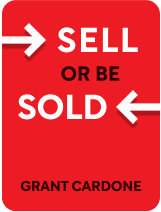

This article is an excerpt from the Shortform book guide to "Sell or Be Sold" by Grant Cardone. Shortform has the world's best summaries and analyses of books you should be reading.
Like this article? Sign up for a free trial here .
Why must you master the art of selling yourself? How do you sell yourself?
Selling yourself effectively is crucial to convincing customers that you believe in the product you are promoting to them. Buyers will sense your lack of conviction if you don’t know how to sell yourself. You sell yourself successfully by having an unyielding conviction in the superiority of the product you are selling and truly believing that not buying your product from you is the worst decision of someone’s life.
Read on to learn more about selling yourself to customers.
Selling Yourself First
In the previous chapter, we looked at four steps to becoming a master salesperson. Now, it’s time to learn the art of selling yourself. Before you can sell something to someone, you first have to sell yourself on it, because if you don’t believe in the product, buyers will sense your lack of conviction and won’t make a purchase.
Below are the secrets to selling yourself successfully:
1. Be unreasonable in your conviction that what you’re selling is superior. Never even let it cross your mind that there might be something out there that can compete with your product. Your belief should be unshakeable in the face of customer objections, and if you’re truly convinced, no one will even challenge you.
- For example, the people who work at Apple stores love Apple products. None of them would even consider buying a PC.
2. Ignore any negatives associated with your product and concentrate only on the positives. Every week, make a list of why you (and others) should own the product.
3. Be willing to buy the product yourself at the price you’re asking because you think the product is worth every penny. Expense is no excuse. If you believe that the product is guaranteed to work out (as you will need to, to be sold on it), then you should have no trouble using all your savings or going into debt to buy it. Every week, make a list of why the product is worth the money.
- For example, when Cardone was selling a house that was worth $6 million, he set the asking price at $8.9 million because the house was in a great location and he thought that was valuable. He would have paid that price for the house and location himself, and only two months later, he sold it for just under the asking price.
4. Believe that not buying your product from you is the worst decision of someone’s life. You must think that failing to convince her to buy is an unethical disservice that you lose sleep over.
If you’re having trouble selling yourself on your product, buy it yourself. This will automatically make you more sold on it. Additionally, owning what you’re selling is one of the strongest ways to demonstrate conviction to others.
- For example, when a car insurance and finance salesman was having trouble selling, he approached Cardone for help. The salesman had just bought a car but hadn’t bought any of the products he sold. Cardone told him to buy his products, and once he did, his income increased by 400%.
There are some products for which selling yourself is impossible—therefore, you won’t be able to sell them. For example, if you think smoking is unhealthy, you won’t be able to sell cigarettes. This is fine. You don’t need to be able to sell every product to be a good salesperson.

———End of Preview———
Like what you just read? Read the rest of the world's best book summary and analysis of Grant Cardone's "Sell or Be Sold" at Shortform .
Here's what you'll find in our full Sell or Be Sold summary :
- How your happiness and even survival depend on your selling ability
- The five steps to becoming a master salesperson
- Step-by-plans to lead the customer to make a purchase






